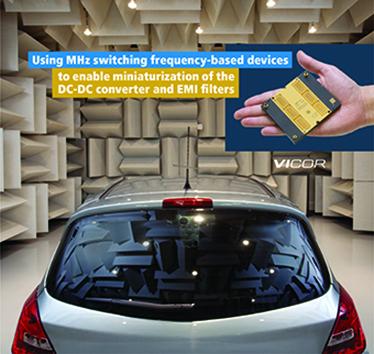
MHz switching frequency-based devices enable miniaturization of the DC-DC converter and EMI filters
Achieving EMI conducted emission compliance for automobiles with a single stage filter. By Nicola Rosano, Sr. Strategic FA/System Engineer at Vicor
More details...
A full brick package developed by TDK-Lambda, the PF1500B-360, is for high voltage distributed power architectures
More details...
Navitas says its latest generation of 650 V and 1200 V ‘trench-assisted planar’ SiC MOSFETs combined with an optimised, HV-T2Pak top-side cooled package, delivers the industry’s highest creepage of 6.45 mm to meet IEC-compliance for applications up to 1200V.
Navitas’ HV-T2PaK SiC MOSFETs can significantly increase system-level power density and efficiency while improving thermal management and simplifying board-level design and manufacturability. Target applications include EV on-board chargers (OBC) & DC-DC converters, data-center power supplies, residential solar inverters & energy storage systems (ESS), EV DC fast chargers, and HVAC motor drives.
AEC-Q101 is an automotive industry standard developed by the Automotive Electronics Council (AEC) to establish common part-qualification and quality-system standards. Navitas says it has created an industry-first benchmark, ‘AEC-Plus’*, indicating parts qualified above and beyond the existing AEC-Q101 and JEDEC product qualification standards and this new benchmark showcases its deep understanding of system-level lifetime requirements and a strong commitment to enabling rigorously designed and validated products for demanding mission profiles in automotive and industrial applications.
- Dynamic reverse bias (D-HTRB) & dynamic gate switching (D-HTGB) to represent stringent application mission profiles
- Over 2x longer power & temperature cycling
- Over 3x longer duration for static high-temperature, high-voltage tests (e.g. HTRB, HTGB).
- 200°C TJMAX qualification for overload operation capability
In addition, the exposed thermal pad has a nickel, nickel-phosphorus (NiNiP) plating, as opposed to tin (Sn) plating from existing TSC package solutions, which is critical to preserving the post-reflow surface planarity of the exposed pad and ensuring thermally efficient and reliable attachment to the thermal interface material (TIM).
Enabled by over 20 years of SiC technology innovation leadership, Navitas’ GeneSiC ‘trench-assisted planar SiC MOSFET technology’ offers up to 20% lower on-resistance under in-circuit operation at high temperatures compared to competition and superior switching figure-of-merits which result in the lowest power losses across a wider operating range. All GeneSiC SiC MOSFETs have the highest-published 100%-tested avalanche capability, excellent short-circuit withstand energy, and tight threshold voltage distributions for easy paralleling.
The initial HV-T2PaK portfolio includes 1200 V SiC MOSFETs with on-resistance ratings ranging from 18 mΩ to 135 mΩ and 650 V SiC MOSFETs with on-resistance ratings ranging from 20 mΩ to 55 mΩ. Lower on-resistance (<15 mΩ) SiC MOSFETs in HV-T2Pak package will be announced later in 2025.
*Navitas uses the term ‘AEC-Plus’ to indicate parts exceeding AEC-Q101 standards for reliability testing, published by the Automotive Electronics Council (AEC), based on Navitas test results
View PDF
| Privacy Policy | Site Map | © Copyright DFA Media
| Web design by Immersive Media


